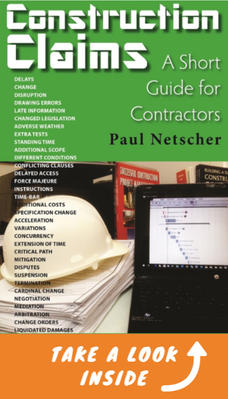"Are you making money on your construction project? Do you know?" I’ve always prepared monthly project cost reports for my construction projects. They’ve often been the fun part of the project where we’ve seen how well we’ve done that month on the project – how much profit we have made. Of course, there have been some construction projects where we’ve lost money, and these cost reports haven’t been quite as fun. These cost reports produced their own challenges as we tried to figure out where we were losing money and what we could do to recover the money and prevent further losses in the future. Construction project cost reports can provide a huge amount of valuable and useful information which can literally save projects, save companies, and save lots of money. But unfortunately, some cost reports are wholly inappropriate for the construction industry, others are done poorly, and a few take an inordinate amount of time to complete. Many don’t utilize the correct information - all of which can mean that the project team wastes their time producing misleading or useless data. In some cases, the data may be out of date by the time it’s produced while in other cases the data is simply ignored. "Is your cost report providing the right information for your construction project?" The good - how cost reports can help your construction projectMake sure your cost reports process is setup to help in the following ways:
"Don't work for free on your construction project. Learn how to submit and win variation claims and change orders." The bad - cost report mistakesUnfortunately, some cost reports can be complex and time consuming to prepare. Furthermore, contractors sometimes make errors in their cost reports which then provide bad data. Occasionally management ignores the cost report and doesn’t take action to figure out why the project is incurring losses, or they misinterpret what the cost report is showing. Some Project Managers leave the preparation and interpretation of the cost report entirely to their Estimators or Contract Administrators and pay little attention to the end report. They view it as just another document produced for their senior managers. The CONSTRUCTION project MANAGER'S financial duties You’ll likely find the following problems with costs reports:
"Does anyone look at your cost reports? Do you follow up to find why the project is losing money? The ugly in cost reports - lies, manipulation and moreBut even when the project team has all the correct information we can encounter ugly, dangerous problems:
Improving construction cost reporting
Construction cost reports are valuable when done properlyRegular construction project cost reports are invaluable and can provide much useful information. However cost reports with the incorrect information can give the project team a false sense of security. It’s essential that cost reports are kept relatively simple and also that companies have accounting systems which can quickly and easily provide accurate data to support the cost report. It’s important to investigate anomalies in cost reports. Don’t just take the report at face value. I’ve discussed investigating your losses, but sometimes it’s equally important to investigate where you are making money. You don’t want to find later that where you thought you were profitable you actually aren’t, and there were in fact errors with your report. Is your construction project losing money? Do you want to find out why? This article was first published on the Insightful Accountant website. Click the link to continue reading. Written by Paul Netscher Please share this post Learn more about Construction Project Management"Have read two of your books and their practical slant make them essential reading for any budding construction PM, they should be on academic reading lists rather than those dull theoretical PM texts kids are made to read! " To read more about the author’s books and find out where you can purchase them visit the pages on this website by clicking the links below:
'Successful Construction Project Management: The Practical Guide' 'Building a Successful Construction Company: The Practical Guide' 'Construction Book reviews' To read more about the author visit the page 'Paul Netscher' Want to contact Paul Netscher please enter your details on 'Contacts' Find out how Paul Netscher can help you Order your books from Amazon Order your books from Amazon UK © 2016 This article is not to be reproduced for commercial purposes without written permission from the author. construction management construction project management
0 Comments
Leave a Reply. |
As an Amazon Associate I earn from qualifying purchases
Archives
January 2024
CategoriesCopyright 2016 - The attached articles cannot be reproduced for commercial purposes without the consent of the author.
The opinions expressed in the attached articles are those of the writer. It should be noted that projects are varied and different laws and restrictions apply which depend on the location of the contractor and the project. It's important that the reader uses the supplied information taking cognisance of their particular circumstances. The writer assumes no responsibility or liability for any loss of any kind arising from the reader using the information or advice contained herein. "I have what I consider some of the best books on construction management."
Books are available from: Amazon.com Amazon.co.uk takealot.com kalahari.com Amazon.in Amazon.de Amazon.fr Amazon.it Amazon.com.au Powell's Fishpond uread bokus Amazon.ca Amazon.es Other retail stores Available in paperback or on Kindle "28 YEARS OF CONSTRUCTION PROJECT MANAGEMENT EXPERIENCE, DEVELOPING SUCCESSFUL CONSTRUCTION PROJECT MANAGERS AND BUILDING SUCCESSFUL CONSTRUCTION COMPANIES"
|







 RSS Feed
RSS Feed